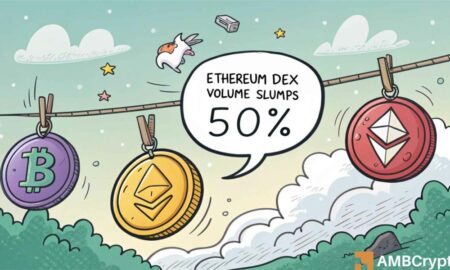Title: The Impact of Trump’s Tariff Announcement on the Cryptocurrency Market
In a rapidly changing economic landscape, recent announcements from U.S. President Donald Trump regarding new tariffs have sent shockwaves through the cryptocurrency market. With an eye-popping $490 million wiped off the crypto sphere, Bitcoin (BTC) and Ethereum (ETH) faced steep declines, reflecting how sensitive digital assets are to shifts in global macroeconomic policies. The imposition of a minimum 10% tariff on all imports—rising to 34% for China, 24% for Japan, and 20% for the European Union—sparked immediate and significant reactions in both traditional and cryptocurrency markets. This article delves into the fallout from these tariffs, focusing on their direct impact on crypto prices, market sentiment, and overall trading dynamics.
On April 3rd, amidst heightened trading activity, Bitcoin plummeted from $88,500 to $83,500, while Ethereum fell from $1,934 to below $1,800. The repercussions were profound, steering the total crypto market capitalization down by 2%, landing close to $2.68 trillion. The rapid and severe response underscores a critical aspect of the current crypto market: its vulnerability to global policy changes. In a time when many investors are looking to digital assets as a hedge against traditional market volatility, these tariffs have illuminated just how interconnected these markets truly are. The social and economic implications of increased trade costs reached far beyond physical goods, spilling over into the digital realm.
The tariff announcement resulted in significant liquidations across the cryptocurrency market, with over 160,000 traders feeling the brunt of the sell-off. This led to more than $490 million in leveraged positions being eliminated. Notably, the largest single liquidation occurred on Binance, involving an ETH/USDT position worth $12 million. Bitcoin futures contributed about $170 million in liquidations, while Ethereum contracts added $120 million, underscoring the substantial risks traders take in leveraged positions. Interestingly, both bullish (long) and bearish (short) traders suffered losses, with approximately $257 million stemming from long liquidations, against $232 million from shorts.
Market sentiment shifted dramatically in the wake of the tariff news. Initially, there was a brief period of optimism as traders reacted to the unfolding situation. However, this optimism quickly faded as the gravity of the situation sunk in. Analyst Rachael Lucas reported a notable 46% uptick in trading volume, primarily driven by larger institutions re-evaluating their positions while retail traders adopted a more cautious approach. The Crypto Fear & Greed Index, which had previously registered neutral sentiment, plummeted to a fearful 24. This sudden shift serves as a reminder of the precarious nature of crypto investments in relation to policy changes, illustrating the fragility of trader confidence during economic upheaval.
The adverse impacts of Trump’s announcement rippled across the broader stock market, with S&P 500 futures seeing a staggering loss of $2 trillion in market capitalization within a mere 15 minutes post-announcement. Major tech stocks experienced plummeting prices: Apple, Amazon, and Nvidia each saw significant declines. As cryptocurrency markets have become increasingly correlated to traditional equities, this broad sell-off inevitably spilled over, exacerbating the losses in crypto assets. In essence, the panic reflected in traditional finance amplified the downturn in the crypto sector. This growing interdependence raises critical questions about future market responses to economic news, making it essential for investors to remain alert to changing conditions.
In conclusion, the sharp downturn in the cryptocurrency market can be directly attributed to the tariff announcements from the U.S. government. The tariffs not only triggered mass liquidations but also coincided with an overall sell-off in global equities. It is crucial to recognize that the current state of the cryptocurrency market is highly impacted by geopolitical policies and economic regulations, rather than just market rumors. Moving forward, understanding the intersection between policy changes and investor sentiment will be vital for navigating the ever-evolving landscape of digital assets. As investors continue to adapt to these changes, the importance of staying informed and agile in the face of policy shifts cannot be overstated.
In the weeks and months ahead, the crypto community will be watching closely how trade policies evolve and whether they will lead to a stabilization or continued volatility in digital currencies. The resilience of the crypto market will be tested as it faces external geopolitical pressures and seeks to forge its own path forward in an uncertain economic climate. This incident serves as a stark reminder that while cryptocurrencies offer potential for high returns, they continue to be significantly influenced by traditional market forces and global economic policy decisions.
















